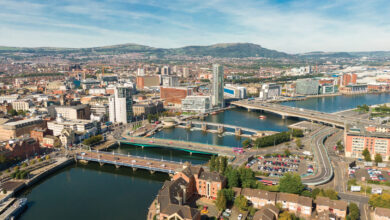Changing lives through regeneration

Voted Northern Ireland’s Social Enterprise of the Year 2017, agendaNi visits Ashton Community Trust (ACT) to explore their successes, model of sustainability and visions for expansion.
The economic value of the social enterprise in Northern Ireland is somewhat undervalued. Public awareness around exactly what a social enterprise provides is relatively low and as a result, the challenging landscape in which social enterprises often operate are made more difficult by a lack of funding and support.
However, despite the challenging landscape, the amount of social enterprises in Northern Ireland has been growing steadily in recent years. For many of these newly-established organisations, Ashton Community Trust (ACT) in north Belfast, is a model in which they aspire to follow.
Founded in the late 1980’s, prior to the term ‘social enterprise’ being utilised, ACT was a community co-operative who sought to retain community-owned facilities amongst redevelopment of the area. In 1991 ACT opened the Ashton Centre, in the New Lodge areas of north Belfast, an area of chronic unemployment and deprivation.
Over two decades on and ACT now directly employs over 200 people and has an annual turnover of around £7 million, providing joined-up services which range from training and employment and property development, through to childcare.
Paul Roberts, ACT’s Chief Executive explains that the organisation had to withstand a turbulent beginning: “On our initial establishment, the engine to drive regeneration was to be a co-operative supermarket; but at the same time Yorkgate (a nearby retail park now known as City Side Belfast) opened and so in those first few years we had to make a lot of changes and rethink what we did.”
 The enterprise’s initial plans were based around the provision of the supermarket, offering units to let and training and employment services, however, with the fall of the supermarket idea, new thinking needed to be introduced.
The enterprise’s initial plans were based around the provision of the supermarket, offering units to let and training and employment services, however, with the fall of the supermarket idea, new thinking needed to be introduced.
“We came to the conclusion that while units to let could be a basis for regeneration resources, these units wouldn’t be primarily occupied by the north Belfast community, nor would they be working in those units. It wouldn’t have the impact we desired and so we put a greater focus on training and employment, in an area with the highest unemployment levels and highest economic inactivity, and a big focus on childcare provision, which is often a barrier to employment.”
ACT currently owns and operates three childcare centres in north Belfast employing over 70 people with development underway to open a fourth in May.
Outlining the variety of services ACT now offers alongside its training and employment and childcare services, Roberts points to health services. Ashton’s Bridge of Hope department provides wellbeing services to those affected by the conflict and poor mental health. It has several strong partnerships and supports people through funding streams made possible by the Victims and Survivors Service via The Executive Office (TEO), Belfast Health and Social Care Trust (BHSCT) and Public Health Agency (PHA). Bridge of Hope is a Primary Care Talking Therapies Hub provider and delivers psychological services to individuals experiencing common health problems in Belfast. It also supports individuals affected by suicide, suicide ideation and self-harm under its PHA Protect Life contract with complementary therapies and counselling. Interestingly most of the staff delivering these services have been trained through Ashton.
ACT also boasts one of the most ambitious youth and arts programmes in Belfast. New Lodge Arts delivers a 7-nights-a-week youth centre, organise the biggest non-denominational parade across north Belfast and has developed many partnerships across the sector to allow young people to perform in Belfast’s most notable venues. It has been successful in raising the aspirations of those taking part and is hailed for the experience and confidence it offers to young people in deprived areas.
Another major success of ACT has been the introduction of FabLab, a digital fabrication laboratory, equipped to inspire people and entrepreneurs to turn their ideas into new products and prototypes by giving them access to a range of advanced digital manufacturing technology. As Roberts explains, the lab is not only a space for new entrepreneurs but also future entrepreneurs, allowing children as young as seven-years-old the opportunity to work with previously inaccessible technology, opening the door to potential career paths.
 In order to deliver these services, ACT needs various bases across north Belfast and for this reason property development remains an arm of its services. Ashton now owns and operates 10 sites across north Belfast, most of which were previously derelict. Among these are initiatives such as the deconstruction over 10 years ago of a peacewall on Duncairn Gardens, replaced with shops and apartments.
In order to deliver these services, ACT needs various bases across north Belfast and for this reason property development remains an arm of its services. Ashton now owns and operates 10 sites across north Belfast, most of which were previously derelict. Among these are initiatives such as the deconstruction over 10 years ago of a peacewall on Duncairn Gardens, replaced with shops and apartments.
Speaking about the impact of these services, Roberts explains: “We’re lucky in a sense that we have been running for so long that our impact is probably more obvious than for those relatively new social enterprises. In Ashton, we can see the generational impact we are having. People who attended our childcare facilities are now teaching in our childcare facilities and people who went through our various training and employment schemes are now delivering our services.
“A lot of what we do fits together very well. We deliver services that provide progression routes for the community. Our mission has always been to regenerate north Belfast economically and socially. Now, as one of north Belfast’s largest employers, we are making a realand visible impact.”
Future
Roberts explains that in the current economic climate, demand for grant-aided services are high. For this reason, the high volume of funding drawn down from the European Union, through the European Social Fund (ESF) and the PEACE programmes, is vital.
He, like many others in the third sector, are concerned about any potential loss of funding through Brexit. “Obviously we are concerned that the EU finding will be lost because it’s been a major investor in deprived communities. We are fortunate in that our current funding is guaranteed for the next four years. That’s a good place to be, although uncertainty around what will happen in the future still exists.”
 Roberts believes that, in any case, policy makers closer to home need to turn their focus to investing in training and employment in order to attain the right skills for boosting the local economy and fostering regeneration in areas such as north Belfast.
Roberts believes that, in any case, policy makers closer to home need to turn their focus to investing in training and employment in order to attain the right skills for boosting the local economy and fostering regeneration in areas such as north Belfast.
Discussing the challenges before the sector, he says: “Within government there is a lack of a strategic approach to delivering investment and providing for regeneration. Taking north Belfast as an example, scheduled redevelopment in inner north Belfast across various projects is estimated to be in the region of £1 billion. However, it’s all happening separately and there is no strategy to outline how these developments can make positive changes for the local community.
“We have a new university being built beside the super output area with the worst education and training figures. We need to change this, to improve community consultation, to improve connections and to ensure that development investment makes real and lasting changes in deprived communities.”
Concluding, Roberts offers some advice to budding social enterprises: “I don’t think there is a model that you can just lift and run with. Every journey will have various paths and what we have learned is that partnerships are key. We don’t deliver everything, we try to deliver the services which we know are needed, will improve people’s live and what we are good at. Where there is a gap in services we partner with those people who complement our service offering and we develop those partnerships.
“What we have always done is ensure that our mission, regenerating north Belfast and making people’s lives better, remains core to everything that we do.”






